Text
Materials Innovation Evaluative Report
During this unit, I have learnt a lot about different materials and how they can be used in interesting ways. The lectures that were part of this unit have made me think of my practice in a different way. Before, I had a surface understanding of how materials could be used. However, my eyes have been opened to the many different materials out there and the ways of using them that can be applied to my own work. As a graphic designer, you sometimes get in the habit of only thinking and creating in 2D but after this unit I would like to see how I can incorporate ideas from the research I do on materials to create things that can work in both 2D and 3D.
The research also made me think more about the needs of humankind and the environment. A lot of the unique designs that I found focused on things that are practical – that anyone can use. For example, the probiotic sanitary pads by Giulia Thomasello. They are aimed at women who want to care for their vaginal health. The product she created is something that is natural, small and can be easily worn. Another example is the Nienke Hoogvliet tableware made out of recycled toilet paper that meets the needs of a country that is struggling with waste and a world that is effected by the burning of it. Designs like these make me think of the ways that I can use my own designs to solve problems. It also reminds me that sustainability and design that is eco-friendly is so important; often natural materials work even better than synthetic materials plus, they are less harmful to humans.

(Studio Nienke Hoogvliet, 2017)
Researching articles each week has helped me to see that knowing the process of how something is made, informs my work. Having this knowledge helps me to know how to use materials, what to use it with, what alternatives are available etc. Knowing what goes into the steps from the start – the raw materials – to the finish – my final product will make me appreciate more whatever project I do. Thomas Thwaites Toaster project was very powerful in showing how much effort is put into the things we use daily that we take for granted. Even though the Toaster didn’t look appealing or, even like a toaster and, it didn’t work properly in the end, it sold for thousands because of the lengths Thwaites took to make it from scratch. The project changed his thinking and the way that he viewed the world around him. It had the same effect for me, even though I just heard and watched the projects documentation. He must have also learned a lot along the way that would help him in his future practice.

(Ballon, 2017)
In terms of changing the way I view the world around me, my research on biomimicry helped to do that. The 3D printed Cillia by researchers at MIT was a really cool example of how aspects of nature can influence practical design. They took inspiration from cilia on cell membranes to create a multiuse material. Another interesting example of biomimicry that I researched was that of the Japanese Shinkansen Bullet Train that uses designs taken from birds to reduce noise. It’s interesting how the natural designs from these birds where applied to something that is ground based but has the same principle of movement.
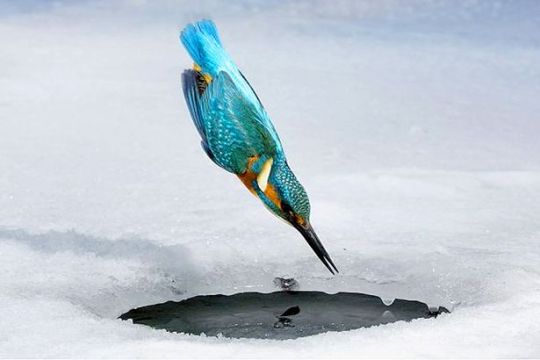
(Delpho, 2017)
This unit has pushed me to think even more outside the box and I am excited to see how it affects my future work.
References
Ballon, N. (2017). [image] Available at: http://www.thomasthwaites.com/the-toaster-project/ [Accessed 16 Jan. 2017].
Delpho, M. (2017). [image] Available at: http://www.mirror.co.uk/news/world-news/brightly-coloured-kingfisher-dive-bombs-5739582 [Accessed 16 Jan. 2017].
Studio Nienke Hoogvliet, (2017). [image] Available at: http://www.nienkehoogvliet.nl/portfolio/waterschatten/ [Accessed 16 Jan. 2017].
0 notes
Text
Dutch Studio Nienke Hoogvliet have made bowls and tables out of recycled toilet paper. The idea seems disgusting and unbelievable but, it was done in response to research finding that “every year 180.000 tons of toilet paper is flushed down the toilets of the Netherlands. This means 180.000 trees!” (Nienkehoogvliet.nl, 2017). The idea was started by two Dutch water authorities, Aa & Maas and Hoogheemraadschap Hollands Noorderkwartier who asked Studio Nienke Hoogvliet to design products using the toilet paper. To salvage the paper from the sewage they installed fine sieves in to the plants that separate it out.

I can’t find any articles on how the toilet paper is turned into the products but i would guess that chemicals and/or heat is added to sterilise it. Then I would assume that it is put into moulds and pressure is applied to form the desired shape.

Two comments on the bottom of the Dezeen article made me question the idea. How can you be certain that the processed toilet paper is completely clean and safe - especially since it’s being used for something you hold food in. Also, even if it is completely sterile, are the chemicals that are added safe to come into contact with food you consume? Recycled toilet paper often contains BPA and BPS which are known carcinogens. Isn’t it possible that this could make it’s way into Studio Nienke Hoogvliet’s tableware?
References
Design Indaba. (2017). Sewer to design: Products made from reclaimed toilet paper | Design Indaba. [online] Available at: http://www.designindaba.com/articles/creative-work/sewer-design-products-made-reclaimed-toilet-paper [Accessed 16 Jan. 2017].
Energie en Grondstoffen Fabriek. (2017). English. [online] Available at: http://www.efgf.nl/english [Accessed 16 Jan. 2017].
Meltingclocktimes.com. (2017). Recycled Toilet Paper, How Do They Get The Shit Out and Is It Sanitary? | Meltingclocktimes.com. [online] Available at: http://meltingclocktimes.com/recycled-toilet-paper-how-do-they-get-the-shit-out-and-is-it-sanitary/ [Accessed 16 Jan. 2017].
Nienkehoogvliet.nl. (2017). Waterschatten. [online] Available at: http://www.nienkehoogvliet.nl/portfolio/waterschatten/ [Accessed 16 Jan. 2017].
Sustainablebabysteps.com. (2017). The Dangers of Recycled Toilet Paper and a Safer Alternative - Sustainable Baby Steps. [online] Available at: http://www.sustainablebabysteps.com/recycled-toilet-paper.html [Accessed 16 Jan. 2017].
Tucker, E. (2017). Nienke Hoogvliet turns used toilet paper into bowls and tables. [online] Dezeen. Available at: https://www.dezeen.com/2016/10/29/studio-nienke-hoogvliet-waterschatten-bowl-table-furniture-dutch-design-week-2016/ [Accessed 16 Jan. 2017].
0 notes
Text
Biomimicry in the ‘Shinkansen’ Bullet Train
An example of successful biomimicry is the Shinkansen bullet train. It is one of the quickest most efficient and eco-friendly ways of travelling between Japan’s major cities. It began transporting passengers in 1964, in time for the Tokyo Olympics. It started off running only between Tokyo and Osaka. Fast forward to today, and there are now 3 types of trains that stops at stations all over Japan’s three islands.
The design of the train has come along way.

A lot was achieved by creating this super fast train but there was the issue of sound pollution. The trains were moving so fast that when entered and exited tunnels they would create sonic booms which disturbed residents in around a 400 metre radius.
It was a man named Eiji Nakatsu, who came up with ideas to solve this problem. The enjineer at JR-West redesigned certain aspects of the train to mimic features of three different birds.
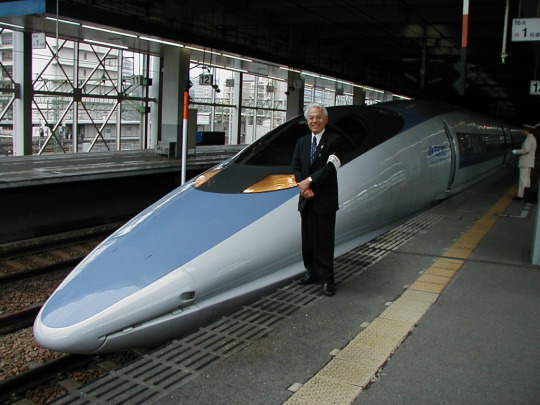
The trains body was altered in line with the King Fisher bird. Nakatsu got the idea after he attended a lecture that was led by an aviation enjineer in 1990. The lecture talked about the inspiration that is taken from birds, to design planes. Nakatsu realised that this could be applied to trains. Kingfishers dive into water to catch fish without making much of a splash, and this is down to their long, thin beak. Nakatsu redesigned the Shinkansen with a long and narrow front that gradually slopes backwards. This would reduce the friction and force of the wind passing by the train.

The second adjustment was done on the pantograph which connects the train to electricity. The component made a lot of noise as the train moved. So Nakata decided to use an Owls feathers as a starting point. The have feathers with serration that “minimize the vortex generated by movement” (Sheppard, 2016).

The owls feather structure
The third aspect that he changed was the frame that supports the pantograph. He mimicked the shape of the Adelie penguins body that helps it move easily through water. This adjustment greatly reduced the frames wind resistance.

Adelie penguin swimming
References
Bloomberg.com. (2016). 8 Innovations Inspired by Nature's Genius. [online] Available at: https://www.bloomberg.com/features/2016-design/a/janine-benyus/ [Accessed 16 Jan. 2017].
Bloomberg.com. (2017). 14 Smart Inventions Inspired by Nature: Biomimicry. [online] Available at: https://www.bloomberg.com/news/photo-essays/2015-02-23/14-smart-inventions-inspired-by-nature-biomimicry [Accessed 16 Jan. 2017].
Gojapango.com. (2017). SHINKANSEN - Go Japan Go. [online] Available at: http://www.gojapango.com/travel/shinkansen.htm [Accessed 16 Jan. 2017].
Gojapango.com. (2017). SHINKANSEN HISTORY - Go Japan Go. [online] Available at: http://www.gojapango.com/travel/shinkansen_history.htm [Accessed 16 Jan. 2017].
GreenBiz. (2017). How one engineer's birdwatching made Japan's bullet train better. [online] Available at: https://www.greenbiz.com/blog/2012/10/19/how-one-engineers-birdwatching-made-japans-bullet-train-better [Accessed 16 Jan. 2017].
Natureinspireus.wordpress.com. (2017). January | 2014 | Biomimesis y bioinspiración para el desarrollo regenerativo y sostenible. [online] Available at: https://natureinspireus.wordpress.com/2014/01/ [Accessed 16 Jan. 2017].
nippon.com. (2017). The Shinkansen Turns 50: The History and Future of Japan’s High-Speed Train. [online] Available at: http://www.nippon.com/en/features/h00078/ [Accessed 16 Jan. 2017].
Sendirimu.xyz. (2017). adelie penguin swimming › Animals. [online] Available at: http://www.sendirimu.xyz/adelie-penguin-swimming/ [Accessed 16 Jan. 2017].
Sheppard, S. (2017). Eiji Nakatsu: Lecture on Biomimicry as applied to a Japanese Train. [online] It is Alive in the Lab. Available at: http://labs.blogs.com/its_alive_in_the_lab/2012/04/biomimicry-japanese-train.html [Accessed 16 Jan. 2017].
1 note
·
View note
Text
Fungi Mutarium
Fungi Mutarium by Livin Studio aims to use fungi to recycle plastic. The interesting part is that this prototype makes an end product that is meant to be eaten. So it is essentially making food out of plastic.

The user has to sterilise the plastic buy placing it under a UV light then add it to the cup-like structure containing the fungi called ‘FU’. This is basically a container made of agar jelly with liquid mycelium in it. Over time the fungi is meant to grow over the agar and the plastic and digest it. The ‘FU’ can then be eaten.

This is such a bizarre yet interesting design. The idea of eating the fungi doesn’t appeal to me at all but the idea that this product can allow anyone to recycle plastic easily is amazing. Landfill is a huge problem around the world so something like this is a great step towards finding new ways of recycling.
L I V I N. (2017). FUNGI MUTARIUM. [online] Available at: http://www.livinstudio.com/fungi-mutarium/ [Accessed 16 Jan. 2017].
0 notes
Text
Lycopodium by Raphael Hefti

These amazing pieces of art were created by burning the spores of the Lycopodium plant in front of photosensitive paper in a blacked out box. It’s basically a hybrid of the photogram.

‘Common to Scandinavia, the spores are highly combustible, so the plant is also known as "witches' powder".’
Hefti has found a really ingenious way of creating art using natural materials. Who would have thought that the seeds of a plant could be used to create amazing photographs.
References
Artsy.net. (2017). Raphael Hefti | From the series «Lycopodium» (2012) | Artsy. [online] Available at: https://www.artsy.net/artwork/raphael-hefti-from-the-series-lycopodium-11 [Accessed 16 Jan. 2017].
En.wikipedia.org. (2017). Lycopodium. [online] Available at: https://en.wikipedia.org/wiki/Lycopodium [Accessed 16 Jan. 2017].
Sherwin, S. (2017). Artist of the week 176: Raphael Hefti. [online] the Guardian. Available at: https://www.theguardian.com/artanddesign/2012/feb/09/artist-of-week-raphael-hefti [Accessed 16 Jan. 2017].
5 notes
·
View notes
Photo

Pour out a puddle (2014) by Jenny Nordberg
Taken from the 3 to 5 seconds series. These mirrors were created by mixing three liquds and then pouring it onto a piece of glass. The process only takes around five minutes and the end result is a set of very unique and oddly shaped puddle mirrors.
I like her idea of trying to create things in a really short space of time. She is juxtaposing the handmade with the mass-produced.
vimeo
Normally we think of handmade items as something that was tediously made with a lot of care and attention but what Nordberg has done here is try to produce handmade objects with the speed of mass-produced objects.
This project remind me a bit of Thomas Thwaites Toaster project. The end results are unique and rough looking.
Jennynordberg.se. (2017). 3 to 5 Seconds | Jenny Nordberg. [online] Available at: http://jennynordberg.se/3-to-5-seconds-rapid-handmade-production-2014/ [Accessed 16 Jan. 2017].
0 notes
Text
3D-printed created by researchers at the Massechusetts Institute of Technology - Cilllia
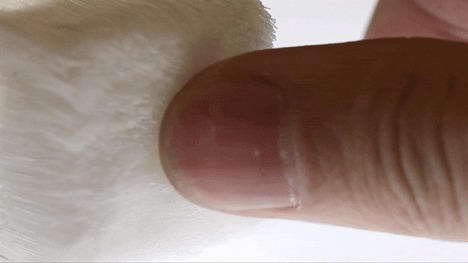
These researches have found a way of printing tiny fibres (50 microns wide) using a 3D printer and, the number of uses this new technology have is way more than you would expect.
Aside from being aesthetic, the fake fur can be used for paintbrushes, as an adhesive (in the same way as velcro) and even as an ‘actuator to move objects’.
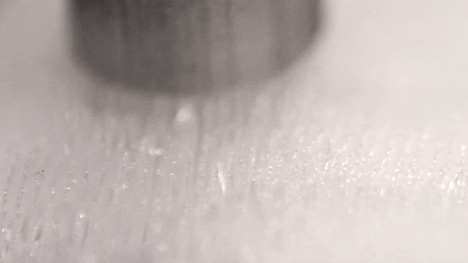
When a vibration is passed through the surface of hair, it becomes an object that can move other objects. This gives it very similar properties to the cilia found of cell membranes - and I guess where the name comes from.
Morby, A. (2016). MIT researchers create 3D-printed programmable Cilllia hair. [online] Dezeen. Available at: https://www.dezeen.com/2016/05/16/mit-researchers-create-3d-printed-hair/ [Accessed 25 Nov. 2016].
0 notes
Photo


Bed (1981) by Antony Gormley @ Tate Britain
This sculpture is made completely out of bread - 8640 slices to be exact - and was created by arranging slices with varying amounts eaten out of. The sculpture forms the hollowed out version of the halves of his body.
To create and preserve the sculpture he dried the pieces of bread and then dipped them in paraffin wax.
This inspires me to think outside of the box. I think sometimes you enter a project having the idea that you’ll venture outside of the box but you don’t end up going that far out.
Tate. (2017). Bed, Antony Gormley 1980–1 | Tate. [online] Available at: http://www.tate.org.uk/art/artworks/gormley-bed-t06984 [Accessed 16 Jan. 2017].
1 note
·
View note
Text
Tina Gorjanc

This artist from central saint martins has developed the conceptual idea of creating leather goods that are made out of the late Alexander McQueen’s skin. Gorjanc proposed that the DNA would be taken from strands of hair left on labels from one of McQueen’s older collections. This information would then be used to harvest skin cell cultures that would be later processed into leather. This is such a wild, morbid and disturbing idea! It makes me feel a little nauseous to be honest... However, the process is interesting.

I think that this kind of idea is like marmite, either you love it or you hate it. Die-hard fans are more likely to be for this idea, but for me personally, I wouldn’t want to use or wear any of this stuff. I’m so drawn to this idea because it’s such an unusual idea to me - the fact thats she’s proposing to use human skin to create something you wear, and that it’ll come from the DNA of someone who’s dead.
Pros and cons of this method of production:
- it seems like it’s more sustainable than making leather traditionally (from cows), however I imagine it would be a a lot more expensive to constantly extract DNA from samples and use it to grow into skin cells in a laboratory.
- i think that using the DNA of someone who’s died to create these products could be a sensitive topic. It would seem more reasonable to use DNA of someone who’s living... Okay that sounds as weird. Hmmm.
I do, however, think that artists using natural materials in this way is great for sustainability and the environment as we are running out of resources. People are becoming more and more conscious of the effect humankind is having on the earth and that the way we think, work and use things needs to change.
Tucker, E. (2016). Alexander McQueen's DNA turned into leather by Tina Gorjanc. [online] Dezeen. Available at: http://www.dezeen.com/2016/07/11/pure-human-tina-gorjanc-leather-fashion-design-central-saint-martins/#more-931354 [Accessed 3 Nov. 2016].
0 notes
Text
Eraser
I want to find out how my eraser was made. I’m not exactly sure what the casing is made of so I’m guessing it’s similar to a regular pen so I’ll use manufacture information for that.

Plastic
Body/casing is likely made of a thermosetting plastic such as phenol formaldehyde resin which stays hard after it is made. This is made by reacting phenol with formaldehyde. Here’ a video showing how it’s formed.
youtube
The casing “can be produced by either extrusion or injection moulding. In each approach, the plastic is supplied as granules or powder and is fed into a large hopper. The extrusion process involves a large spiral screw, which forces the material through a heated chamber, making it a thick, flowing mass. It is then forced through a die, cooled, and cut” (Madehow.com, 2016).

Here’s a diagram showing the process of injection moulding. (Maximintegrated.com, 2016)
Rubber
Rubber can either be made synthetically or naturally. Natural rubber comes from latex which comes from the rubber tree which is found in tropical environments such as Malaysia. It is the trees sap that is the raw material used for rubber. The rubber can then be coloured white using zinc oxide.
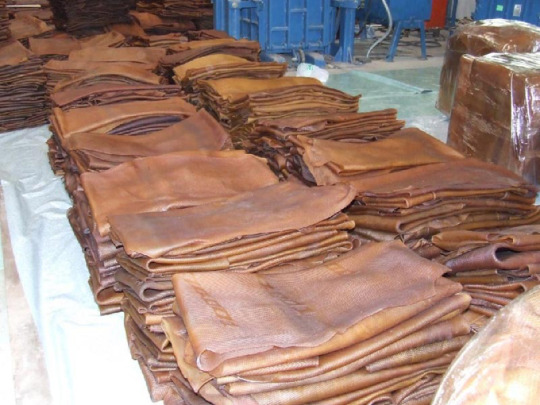
If the rubber is natural it first needs to be turned into a powder “or dissolved in solvent” (Madehow.com, 2017). Then the rubber is mixed with “pigments, vegetable oil, pumice, sulfur, and other ingredients that modify the properties of the final product” (Madehow.com, 2017). The mixture is then heated which causes a chemical reaction with the sulphur making it less reactive.
youtube
video showing how natural rubber is extracted and processed
If the eraser is made from synthetic rubber then most common compound used is styrene-butadiene. The components styrene and butadiene are formed by the process of fractional distillation and catalytic cracking of petroleum. The styrene and butadiene in the form of a liquid are mixed with soap and a catalyst that causes a reaction between the two to form rubber particles. The soap disperses these particles. “Other chemicals added to the mixture include stabilizers, which prevent the rubber from breaking down, and modifiers, which change the properties of the rubber” (Madehow.com, 2016).
youtube
Short video on how synthetic rubber is made
Finally the rubber whether synthetic or natural is injection moulded into the desired shape and allowed to cool.
Madehow.com. (2016). How ballpoint pen is made - material, manufacture, making, history, used, processing, parts, components, dimensions. [online] Available at: http://www.madehow.com/Volume-3/Ballpoint-Pen.html [Accessed 4 Nov. 2016].
Madehow.com. (2016). How eraser is made - material, making, history, used, dimensions, product, History, Raw Materials. [online] Available at: http://www.madehow.com/Volume-5/Eraser.html [Accessed 4 Nov. 2016].
0 notes
Text
01 (Week two)
It was interesting to see how far Thomas Thwaites went to create his own toaster ‘from scratch’. I admire the effort he went through to get the raw materials. It made me ask the question, “why do all of this when you can just buy a cheap toaster?”. Now I understand a bit about the psychology behind the whole project.
“The contrast in scale between between consumer products we use in the home and the industry that produces them is I think absurd – massive industrial activity devoted to making objects which enable us, the consumer, to toast bread more efficiently. These items betray no trace of their provenance.” (Thwaites, 2016)
So, I think what he is saying is that in a way, it doesn’t make sense that such large processes go into making things that carry out really simple duties such as toasting bread. I don’t think I’ve ever thought about this in such depth. But it’s so true.
“Looking close up, a desire (for toast) and the fulfilment of that desire is totally reasonable. Perhaps the majority of human activity can be reduced to a desire to make life more comfortable for ourselves...” (Thwaites, 2016) But he says that when you compare it to what could be done and what is being done by the industry on a large scale, the thought of coveting an item like a toaster seems ridiculous. However Thwaites goes on to say, “but at the same time the chain of discoveries and small technological developments that occurred along the way make it entirely reasonable.” (Thwaites, 2016)
I think that’s true. Huge progress can still be made by looking at/discovering the little, unassuming things. It’s all valuable for the knowledge of society today.
Thetoasterproject.org. (2017). The Toaster Project. [online] Available at: http://www.thetoasterproject.org/page2.htm [Accessed 10 Jan. 2017].
0 notes
Text
Maurizio Savini
Savini creates sculptures out of chewing gum.

Bisonte by Maurizio Savini
Obviously, gum is something that a lot of us chew on a daily basis. It is a confectionary that was originally introduced to Europe by the Americans after the second world war. But the history of gum goes further back than this. It was the native Indians who passed on this tradition to colonists. They showed them that chewing the resin from Spruce trees can help to quench thirst. After this, spruce gum grew in popularity across the States. Other ways of making chewing gum then became popular. However, even before all of this, Ancient Greeks were said to have chewed gum to freshen their breath and to clean their teeth. The gum they used came from Mastic tree resin.

Peter Paul, 2008
At first glance, you would think it strange that someone would you use gum to create art but this is easily matched by the commonplace act of chewing on a substance that is largely indigestible. It does start to make sense that such a malleable substance has been incorporated into sculpture making.
“I like that gum is the only product you’ll put in your mouth but won’t actually eat it.” - (Maurizio Savini, The Creators Project, 2017)
[bubble gum] "is more versatile material compared to those used by the 'traditional' arts, such as painting," - (one of Savini’s assistants, The Creators Project, 2017)

Savini working on one of his sculptures.
Savini doesn’t actually chew the gum when creating a piece (which would probably take forever), he softens it by heating it up. Then “they can easily be manipulated, cut with a knife, and applied to plaster mold like traditional clay” (Emmanuelfremingallery.com, 2017). The plaster mould is used for support as the gum alone would be unstable. To make the sculpture permanent Savini sprays it with formaldehyde and antibiotics.
I love the striking pink colour of his sculptures. Most traditional sculptures tend to be white, off white, cream, grey. Savini consciously uses the colour pink and said that “pink represents artificiality – when you see it, you associate it with a fake world” (Emmanuelfremingallery.com, 2017). I personally feel that other colours such as white or blue could also be associated with artificiality but I do understand Savini’s thought processes. I also think that the pink reminds me of childhood and innocence, especially as it’s linked with chewing gum which makes me think of bubble gum.

American Breakfast, 2016
When I first found out about Savini’s sculptures, I assumed that he made them either from used gum found on the street/in the trash or by chewing each piece himself (which I guess is wishful thinking). But I think it would add to their charm, knowing that they’re either created by the public or that the painstaking task of chewing thousands of pieces of gum went into making those pieces of art.
References
Complex UK. (2017). The Most Unusual Tools Artists Have Ever UsedGum. [online] Available at: http://uk.complex.com/style/2014/06/the-most-unusual-tools-artists-use/gum [Accessed 10 Jan. 2017].
Dynamoartfactory.org. (2017). MAURIZIO SAVINI | Dynamo Art Factory. [online] Available at: http://www.dynamoartfactory.org/en/artista/maurizio-savini-en/ [Accessed 10 Jan. 2017].
Emmanuelfremingallery.com. (2017). Maurizio Savini. [online] Available at: http://emmanuelfremingallery.com/project/maurizio-savini/ [Accessed 10 Jan. 2017].
En.wikipedia.org. (2017). Paraffin wax. [online] Available at: https://en.wikipedia.org/wiki/Paraffin_wax [Accessed 10 Jan. 2017].
Sonia Kolesnikov-Jessop, f. (2017). Singapore breaks ban, welcome chewing gum art. [online] CNN. Available at: http://edition.cnn.com/2016/10/10/arts/maurizio-savini-singapore-chewing-gum-art/ [Accessed 10 Jan. 2017].
The Creators Project. (2017). Everything's Bubble Gum at Maurizio Savini’s New Exhibit | The Creators Project. [online] Available at: http://thecreatorsproject.vice.com/blog/everythings-bubble-gum-at-maurizio-savinis-new-exhibit [Accessed 10 Jan. 2017].
Wrigley.com. (2017). Wrigley.com :: History of Gum. [online] Available at: http://www.wrigley.com/global/about-us/history-gum.aspx [Accessed 10 Jan. 2017].
0 notes